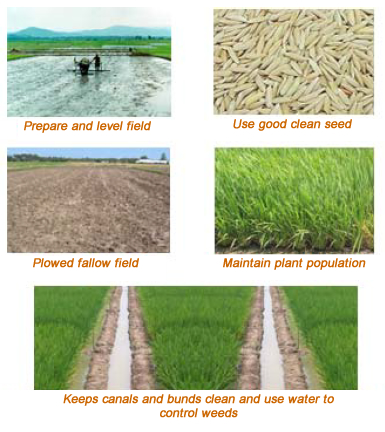Cultural weed control
What is Cultural Weed Control?
Cultural weed control includes non-chemical crop management practices ranging from variety selection to land preparation to harvest and postharvest processing. Cultural weed control is a part of integrated weed management which involves the integrated use of cultural, manual, and/or mechanical control methods.
Why Control Weeds?
- Prevent yield loss due to weed competition
- Maintain purity and/or quality and market price of harvested grain
- Prevent build-up of weed seeds in soil
- Prevent weeds that may attract insects or rodents (rats) or act as a host for diseases
- Prevent clogging of field irrigation channels to facilitate water flow
- Reduce time and cost of land preparation and weeding operations
Why Use Cultural Control of Weeds?
- Cost effective and easy to practice: Acceptable and accessible to small & large farmers
- Non-chemical and ecologically sound
- Prevention is better than cure
How to Use Cultural Practices to Control Weeds?
- Timing: Weeds need to be controlled from planting until the crop canopy closes
- Land preparation and leveling: Use land preparation to control growing weeds and to allow weed seeds to germinate. Kill newly emerging weeds by repeat tillage at adequate (~10-day) intervals.
- Reduce weed entry into fields: Prevent the introduction of weeds into fields by: 1) use clean good quality seed; 2) keep seedling nurseries free of weeds to make sure weeds are not planted with the rice seedlings; 3) keep irrigation channels and field bunds free of weeds to prevent weed seeds or vegetative parts entering the fields; 4) use clean equipment to prevent field/crop contamination; and 5) rotate crops to break weed cycles.
- Fallow management: Kill weeds in fallow fields (e.g., use tillage) to prevent flowering, seed-set and the build-up of weed seeds in the soil (Remember: “one year of seeds, seven years of weeds”).
- Crop-weed competition: Select a weed-competitive variety with early seedling vigor, and high tillering to suppress weeds. Transplanted crops tend to have fewer weeds and less yield loss than direct seeded crops. Transplant healthy, vigorous seedlings that can better compete with weeds in early stages. Maintain an adequate plant population that closes its canopy by maximum tillering to shade out weeds. Apply Nitrogen (N) fertilizer just after weeding to minimize rice-weed competition for N.
- Water management: Water is the best control for weeds. Many weeds cannot germinate or grow under flooded conditions (e.g. most grasses and some sedges). Maintain a 2-5 cm water level in the field to minimize weed emergence and lower weed pressure. If water is sufficient, fields can be continuously flooded from the time of transplanting to when crop canopy covers the soil completely. Good land leveling is critical to avoid high spots where weeds can become established.
Limitations:
- Needs good knowledge and understanding of various cultural practices that can reduce weed pressure
- Continuous vigilance and monitoring are essential to control weeds by cultural methods
- Some practices are labor intensive.
Developed with input from B Chauhan, MA Bell, J Rickman, and V Balasubramanian.








